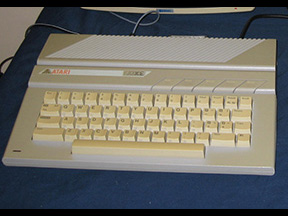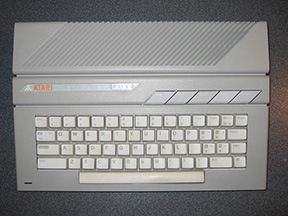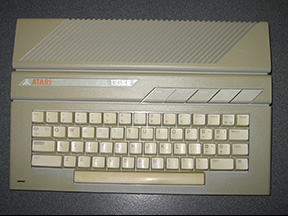| Tweet |
Retr0Bright (or RetroBright) treated plastics re-yellowing even with minimal light exposure?
Introduction
I've been an enthusiastic user of Retr0Bright since the technique was discovered. I've tried it on a number of my yellowed computers, experimenting with easy-to-get ingredients, running trials and generally exploring the method. I reported these experiments in the research section on my Articles/Projects blog. In the main Retr0Brighting seemed effective, and returned my cheese-coloured computers to a degree of respectability.
It was never claimed the treatment alone would stop further yellowing. The consensus of opinion from those that knew the chemistry was that the cases were still vunerable to UV light and that over time the yellowing would again take place unless parts were coated with a UV protectant.
This article shows evidence that yellowing after Retr0Brighting can indeed return over time. The suprise is it happens with seemingly very little UV light. What's more, it only appears to be the plastic initially damaged by yellowing which re-yellows. Plastic that was originally unaffected stays that way.
The observation
Every year I drag my computers out to test them. Last year I noticed some of my de-yellowed units and parts were starting to look yellow again. I thought maybe I was just imagining things. However, this year I've found myself unboxing my computers again, primarily to discuss them in a series of YouTube videos. This time I was sure. Most WERE reverting to their yellowed state.
Storage and exposure to light
All of these Retr0Brighted units except the Lisa and the System 80 were kept in closed-up cardboard boxes in a dark room. The boxes weren't sealed, but they were closed and often had boxes stacked on top of them so the hardware was pretty much in the dark. The System 80 was covered with a blanket, so not much light would get to that either. Only the Lisa sat unboxed. All were in a room that was mostly ever only illuminated by fluorescent light when I worked out there in the evenings or weekends. Very occasionally (only 10-20 days a year) blinds were angled or raised little to allow SOME natural light in but none of these computers or the boxes they sat in were exposed to direct sunlight.
Most machines then, only saw light on the very rare occasions I'd bring them out to test them. For example the Atari 130XE had only been out of its box approximately three times. Even then they were only out for a couple of days at the most and they were never exposed to direct sunlight.
In summer the room could get very warm, pushing 29 degrees C sometimes. I would estimate that for about 30 days of the year, daytime temperatures would be at least 25 degrees C or more.
Method
To illustrate the re-yellowing phenomena, I've taken some comparative photos. I've tried to used the same lighting, camera settings, angles and backgrounds I used for the before-and-after photos when the retr0Brighting was originally done. The exception is the Apple IIe post-Retr0Bright picture, where a side light was used instread of a flash.
Results
The pictures speak for themselves. The only computer not affected seemed to be the Apple Lisa. Ironically, this was the only computer which was not boxed. However it was the most recently treated.
Commodore Vic-20 |
||
 |
 |
 |
December 2008 Pre-Retr0Bright
|
December 2008 Post-Retr0Bright
|
January 2013 (after 4.1 years)
|
Atari 130XE |
||
 |
 |
 |
December 2008 Pre-Retr0Bright
|
December 2008 Post-Retr0Bright
|
January 2013 (after 4.1 years)
|
RX8000 |
||
 |
 |
 |
January 2009 Pre-Retr0Bright
|
January 2009 Post-Retr0Bright
|
January 2013 (after 4.0 years)
|
Apple IIe Platinum |
||
 |
 |
 |
January 2009 Pre-Retr0Bright
|
January 2009 Post-Retr0Bright
|
January 2013 (after 4.0 years)
|
Commodore SX-64 space bar |
||
 |
 |
 |
February 2009 Pre-Retr0Bright
|
February 2009 Post-Retr0Bright
|
January 2013 (after 3.9 years)
|
Dick Smith System 80 |
||
 |
 |
 |
July 2010 Pre-Retr0Bright
|
July 2010 Post-Retr0Bright
|
January 2013 (after 2.5 years)
|
Apple Lisa 2 |
||
 |
 |
 |
December 2010 - Pre-Retr0Bright
|
December 2010 - Post-Retr0Bright
|
January 2013 (after 2.1 years)
|
There is something else. On the Vic 20 and the Apple IIe there is a pale area on the original untreated (yellowed) unit where a cord was lying over cases (most obvious on the Apple IIe). Immediately underneath this cord the yellowing is much less, presumably as it was blocking the light. With retr0brighting this pattern disappeared. However, on both these machines this cord impression is starting to reappear! This is odd as post-treatment all surfaces would have been exposed to equal amount of oxygen or brief light
Discussion
To recap:
- All computers except the Lisa were kept in darkness (but not sealed darkness so a few photons might have been able to penetrate).
- All computers are showing yellowing again, BUT only in the areas where they were already yellowed before treament
- Temperatures can reach 29 deg C in the storage/work room during the day occasionally (but not always) in the summer months.
Conventional theory (i.e. that on the Retr0Bright Wiki) is that wherever these treated plastics are exposed to UV light and unprotected by a UV filter (polish, varnish etc.) then yellowing will re-occur. However, most of these computers were held in darkness? Any stray UV that found it's way through closed blinds and into a closed box buried under others would be minimal (even with New Zealand's high UV levels). It's hard to believe the very brief exposure to light (mostly fluorescent) these computers got when I exercised them would have caused this degree of re-yellowing.
Another theory could be that, with plastics that had ALREADY yellowed, Retr0Bright only temporarily reverses the process. Over time, the oxygen in the air aided by heat causes chemical reactions that re-yellow even in the absence of UV light! I don't know if chemically this is possible but this would seem to fit the evidence above. Either that or yellowed-then-Retr0Brighted plastics are now so sensitive to UV that just a very brief exposure (a few times a year) to stray indirect UV (coming through a window with closed venetian blinds) is enough to reverse the process!
Anyway, comments are welcome. I'll be interested to know if others have found their retr0Brighted cases re-yellowing over time, even in the dark! If so, then Retr0Bright may indeed only be temporary (or maybe heat sensitive). It also has implications as to the worth (or not) of trying to protect de-yellowed cases from re-yellowing with a UV sealant. If UV doesn't play a big role in re-yellowing of retr0Brighted cases then UV protection will have little value.
Update: 16th, 17th Jan
From discussion and reflection a hypothesis has developed which seems to fit the evidence:
The original damage from light causes degraded or free bromides throughout the case from the fire retardants. Retr0Bright only takes
these away from the surface layer. However these bromides can migrate fairly freely through the polymer. They don't need light to do this. Migration is probably accelerated in hot conditions. These pre-existing bromines from the original damage migrate to the top and
within a few years the surface is yellowed again. The rate of the regression depends on the inital extent of yellowing (the more yellowed, the more bromides down deep), heat exposure and the nature/quality of the plastics.
If this hypothesis is correct then a UV sealant will not protect the case. Or any sealant maybe. Unless pre-formed bromides from previous
light damage can be stopped from migrating to the surface (and I don't know how you would do that) Retr0Bright is only ever going to be
temporary.
Bear in mind this is just a hypothesis which fits the evidence but has not been proven. To prove or disprove it would require research. It seems a logical supposition though.
Discussion is continuing and this update might already be out of date. Follow the latest here. Once the discussion has run it's course, I'll re-edit this article to summarise.
Tez
15th January, 2013
Updated 16th, 17th January, 2013
| Tweet |